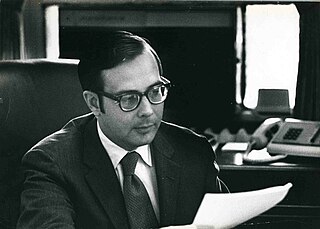Related Research Articles

The Canadian Radio-television and Telecommunications Commission is a public organization in Canada with mandate as a regulatory agency for broadcasting and telecommunications. It was created in 1976 when it took over responsibility for regulating telecommunication carriers. Prior to 1976, it was known as the Canadian Radio and Television Commission, which was established in 1968 by the Parliament of Canada to replace the Board of Broadcast Governors. Its headquarters is located in the Central Building of Les Terrasses de la Chaudière in Gatineau, Quebec.
The People's Republic of China possesses a diversified communications system that links all parts of the country by Internet, telephone, telegraph, radio, and television. The country is served by an extensive system of automatic telephone exchanges connected by modern networks of fiber-optic cable, coaxial cable, microwave radio relay, and a domestic satellite system; cellular telephone service is widely available, expanding rapidly, and includes roaming service to foreign countries. Fiber to the x infrastructure has been expanded rapidly in recent years.
Telecommunications in the Philippines are well-developed due to the presence of modern infrastructure facilities. The industry was deregulated in 1995 when President Fidel Ramos signed Republic Act No. 7925. This law opened the sector to more private players and improved the provision of telecom services are better and fairer rates, leading to the creation of many telecommunication service providers for mobile, fixed-line, Internet and other services.
This article covers telecommunications in Sweden.
Communications in the United States include extensive industries and distribution networks in print and telecommunication. The primary telecom regulator of communications in the United States is the Federal Communications Commission.
The Kingsbury Commitment is a 1913 out-of-court settlement of the United States government's antitrust challenge against the American Telephone and Telegraph Company (AT&T) for the company's then-growing vertical monopoly in the telecommunication industry. In return for the government's agreement not to pursue legal action against the company as a monopolist, AT&T agreed to divest the controlling interest it had acquired in the Western Union Telegraph Company, and to allow non-competing independent telephone companies to interconnect with the AT&T long-distance network.

MCI Communications Corporation was a telecommunications company headquartered in Washington, D.C. that was at one point the second-largest long-distance provider in the United States.

The Telecommunications Act of 1996 is a United States federal law enacted by the 104th United States Congress on January 3, 1996, and signed into law on February 8, 1996, by President Bill Clinton. It primarily amended Chapter 5 of Title 47 of the United States Code.

The telecommunications policy of the United States is a framework of law directed by government and the regulatory commissions, most notably the Federal Communications Commission (FCC). Two landmark acts prevail today, the Communications Act of 1934 and the Telecommunications Act of 1996. The latter was intended to revise the first act and specifically to foster competition in the telecommunications industry.

The breakup of the Bell System was mandated on January 8, 1982, by a consent decree providing that AT&T Corporation would, as had been initially proposed by AT&T, relinquish control of the Bell Operating Companies, which had provided local telephone service in the United States. This effectively took the monopoly that was the Bell System and split it into entirely separate companies that would continue to provide telephone service. AT&T would continue to be a provider of long-distance service, while the now-independent Regional Bell Operating Companies (RBOCs), nicknamed the "Baby Bells", would provide local service, and would no longer be directly supplied with equipment from AT&T subsidiary Western Electric.
COMSAT is a global telecommunications company based in the United States.

The Communications Satellite Act of 1962 was put into effect in order to deal with the issue of commercialization of space communications. This act was very controversial, and was left very open-ended. The act was signed August 31, 1962 by President John F. Kennedy.

Clay T. "Tom" Whitehead was a United States government official who served as special assistant to the president from 1968 to 1970; director of the White House Office of Telecommunications Policy (OTP) from 1970 to 1974 during the Nixon administration; director of the Ford Transition Team immediately before Nixon's resignation; and an operative in the White House during the initial phases of the Ford transition. Whitehead pioneered a policy of competition across the telecommunications industries, which later was reflected in legislation and regulations in the United States and around the world.
United States v. AT&T was the antitrust case in the United States that led to the 1982 Bell System divestiture, the breakup of the old American Telephone & Telegraph into the new, seven regional Bell operating companies (RBOC)s and the much smaller new AT&T.

The Bell System was a system of telecommunication companies, led by the Bell Telephone Company and later by the American Telephone and Telegraph Company (AT&T), that dominated the telephone services industry in North America for over 100 years from its creation in 1877 until its antitrust breakup in 1983. The system of companies was often colloquially called Ma Bell, as it held a vertical monopoly over telecommunication products and services in most areas of the United States and Canada. At the time of the breakup of the Bell System in the early 1980s, it had assets of $150 billion and employed over one million people.

AT&T Corporation is the subsidiary of AT&T Inc. that provides voice, video, data, and Internet telecommunications and professional services to businesses, consumers, and government agencies.
Stuart N. Brotman is an American government policymaker; tenured university professor; management consultant; lawyer; author and editorial adviser; and non-profit organization executive. He has served in four Presidential Administrations on a bipartisan basis and taught students from 42 countries in six separate disciplines — Communications, Journalism, Business, Law, International Relations and Public Policy. He also has advised private and public sector clients in more than 30 countries in five continents.
Network convergence refers to the provision of telephone, video and data communication services within a single network. In other words, one company provides services for all forms of communication. Network convergence is primarily driven by development of technology and demand. Users are able to access a wider range of services, choose among more service providers. On the other hand, convergence allows service providers to adopt new business models, offer innovative services, and enter new markets.
The history of AT&T dates back to the invention of the telephone. The Bell Telephone Company was established in 1877 by Alexander Graham Bell, who obtained the first US patent for the telephone, and his father-in-law, Gardiner Greene Hubbard. Bell and Hubbard also established American Telephone and Telegraph Company in 1885, which acquired the Bell Telephone Company and became the primary telephone company in the United States. This company maintained an effective monopoly on local telephone service in the United States until anti-trust regulators agreed to allow AT&T to retain Western Electric and enter general trades computer manufacture and sales in return for its offer to split the Bell System by divesting itself of ownership of the Bell Operating Companies in 1982.
Communications law refers to the regulation of electronic communications by wire or radio. It encompasses regulations governing broadcasting, telephone and telecommunications service, cable television, satellite communications, wireless telecommunications, and the Internet.
References
- ↑ Owen, Bruce M. (2003). "A Novel Conference: The Origins of TPRC," Communication Researchers and Policy-Making, Sandra Braman, ed.
- ↑ The National Archives, Records of the NTIA
- 1 2 Obituary of Clay T. Whitehead, The New York Times
- ↑ (1976-04-17) "Ex-F.C.C. Member Set for White House TV Post," The New York Times.
- 1 2 Garvin, Glenn (2008-08-03). "His Ideas Launched the Future". The Miami Herald.
- ↑ Lewis, Paul (2001-05-24). "Philip W. Buchen, 85, Is Dead; Advised Ford on Nixon Pardon," The New York Times
- ↑ Cornell University Law School Antonin Scalia Biography, https://www.law.cornell.edu/supct/justices/scalia.bio.html.
- ↑ September 1998 Cable Center interview of Brian Lamb, http://www.cablecenter.org/education/library/oralHistoryDetails.cfm?id=132.
- ↑ "Wired, Zapped, and Beamed, 1960's through 1980's".
- ↑ "The White House Press Conference of Peter M. Flanigan, Assistant to the President, and Clay T. Whitehead, Staff Assistant," Office of the White House Press Secretary, January 23, 1970.
- 1 2 Brown, Les (1974-01-17). "Press Freedom for Cable TV is Urged in Whitehead Report". The New York Times.
- 1 2 Park, Rolla Edward, ed. (1972). The Role of Analysis in Regulatory Decisionmaking: The Case of Cable Television.
- 1 2 3 The Cabinet Committee on Cable Communications (1974). Cable: Report to the President.
- ↑ Irwin, Don (1974-01-17). 'Plan for Developing Cable TV Offered,' Los Angeles Times
- ↑ By December 1973, AT&T had a near monopoly on local phone service relative to independent service providers, a monopoly on all voice traffic international communication, a monopoly of the telephone equipment market, and its Long Lines division held a monopoly on long distance inter-state transmission of telephone message traffic. See, e.g., Office of Telecommunications Policy, The Telephone Industry and Antitrust: A Report on Anticompetitive Practices of the Bell System, Preface at 1-3 (Dec. 1973). Further, it enjoyed an 80-90% share of long distance specialized business services such as data transmission and television signals, as well as the customer terminal equipment market. Ibid.
- ↑ See, e.g., In re: Establishment of Domestic Communications-Satellite Facilities by Non-Governmental Entities, Docket No. 16495, 38 F.C.C.2d 665 at *12 (Dec. 22, 1972) (requiring AT&T to divest its 29% ownership in Comsat if it wants to compete in offering domestic satellite services because "the competitive roles which Comsat and AT&T are assuming in the domestic communications field dictate the need for maximum independence from each other and an arms-length relationship.")
- ↑ Coll, Steve. The Deal of the Century: The Breakup of AT&T 60-61 (1986).
- ↑ See, e.g., Office of Telecommunications Policy, (Dec. 1973). The Telephone Industry and Antitrust: A Report on Anticompetitive Practices of the Bell System, Chapter IX Summary and Conclusions at 5 (arguing that Bell's "divestiture of Long Lines is almost certainly required" to increase competition in the "specialized carrier, miscellaneous common carrier, and domestic satellite markets.").
- 1 2 Shifrin, Carole (1974-07-10). "Greater Non-Phone Competition Urged". The Washington Post.
- ↑ Burnham, David (1974-07-31) 'AT&T Defends Size and Power,' The New York Times, p. 41 (Senate subcommittee "hearings were held several days after the Justice Department acknowledged that its Antitrust Division for the last year has been investigating the company for possible antitrust violations . . . .")
- 1 2 3 4 5 Clay T. Whitehead Testimony on S. 1167 before Subcommittee on Antitrust and Monopoly. 1974-07-09.
- ↑ Clay T. Whitehead Testimony on S. 1167 before Subcommittee on Antitrust and Monopoly, July 9, 1974 at 8 ("[U]nless the would-be monopolist or the public can demonstrate special public policy considerations that justify monopoly, it should not be permitted. . . . At present there does not appear to be any service other than the local public telephone service where monopoly rather than competition would best serve the public interest.").
- ↑ Mathews, Linda (1974-11-21) 'Justice Dept. Sues to Break Up AT&T,' Los Angeles Times, at OC1. As Whitehead hoped, one remedy sought was horizontal divestiture. ("In addition, the department asked that AT&T be forced to sell stock and assets to separate its long lines department, which handles 90% of the nation's interstate phone calls, from the local Bell Telephone companies.").
- ↑ A.P., 'Justice Dept., AT&T Accept Judge's Antitrust Conditions,' Los Angeles Times, Aug. 19, 1982, at A2.